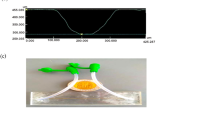Abstract
Infertility in a large proportion of infertile couples is due, in part, to the male factor. Spermatozoa must survive the unique environment of the female reproductive tract in their path to fertilize the ovum. This fact is even more problematic for men with oligospermia. Of the many environmental factors that effect sperm motility in the female reproductive tract, we have decided to concentrate on the effect of pH and viscosity on bovine spermatozoa in the laboratory setting. Follicular fluid was harvested from heifer ovaries to serve as a chemo-attractant. Through image analysis, our data shows trends of sperm motility as a function of pH and viscosity. There is a significant increase in the number of immotile sperm seen as pH decreases from 6.5 to 6.0. Furthermore, an exponential relationship between sperm speed and environmental viscosity was observed in vitro. This suggests that modulating vaginal pH and vaginal secretion viscosity could greatly affect spermatozoa motility and therefore male fertility.



Similar content being viewed by others
References
Balercia G, Regoli F, Armeni T, Koverech A, Mantero F, Boscaro M (2005) Placebo-controlled double-blind randomized trial on the use of L-carnitine, L-acetylcarnitine, or combined L-carnitine and L-acetylcarnitine in men with idiopathic astenozoospermia. Fertil Steril 84(3):662–671
Beers MH (2003). “Vaginal infections.” The Merck Manual. http://www.merck.com/mmhe/sec22/ch247/ch247a.html
Boskey ER, Telsch KM, Whaley KJ, Moench TR, Cone RA (1999) Acid production by Vaginal Flora in vitro is consistent with the rate and extent of vaginal acidification. Infect Immun 67(10):5170–5175
Boskey ER, Cone RA, Whaley KJ, Moench TR (2001) Origins of vaginal acidity: high D/L lactate ratio is consistent with bacteria being the primary source. Hum Reprod 16(9):1809–1813
Cerikcioglu N, Beksac MS (2004) Cytolytic vaginosis: misdiagnosed as candidal vaginitis. Infect Dis Obstet Gynecol 12:13–16
Eisenbach M (1999) Sperm chemotaxis. Rev Reprod 4:56–66
Gibbons RA (1959) Chemical properties of two mucoids from bovine cervical mucin. J Biochem 73:209–225
Gorodeski GI (2000) NO increases permeabilty of cultured human cervical epithelia by cGMP-mediated increase in G-actin. Am J Physiol—Cell Physiol 278(5):C942–C952
Guffanti AA, Susman P, Blanco R, Krulwich TA (1978) The protonmotive force and alpha-aminoisobutyric acid transport in an obligately alkalophilic bacterium. J Biol Chem 253:708–715
Harraway C, Berger NG, Dubin NH (2000) Semen pH in patients with normal versus abnormal sperm characteristics. Am J Obstet Gynecol 5(182):1045–1047
Lefièvre L, De Lamirande E, Gagnon C (2000) The cyclic GMP-specific phosphodiesterase inhibitor, sildenafil, stimulates human sperm motility and capacitation but not acrosome reaction. J Androl 21(6):929–937
Liu DY, Baker HW (2004) High frequency of defective sperm-zona pellucida interaction in oligiospermic infertile men. Hum Reprod 19(2):228–233
Love CC, Thompson JA, Brinsko SP, Rigby SL, Blanchard TL, Lowry VK, Varner DD (2003) Relationship between stallion sperm motility and viability as detected by two fluorescence staining techniques using flow cytometry. Theriogenology 60:1127–1138
McLachlan RI, Baker HW, Clarke GN, Harrison KL, Matson PL, Holden CA, de Kretser DM (2003) Semen analysis: its place in modern reproductive medical practice. Pathology 35:25–35
Mohammad SN, Barratt CL, Cooke ID, Moore HD (1997) Continuous assessment of human spermatozoa viability during cryopreservation. J Androl 1(18):43–50
Moreira S, Lipshultz L (2004) Management of male infertility. Digit Urol J http://www.duj.com/Article/Moreira.html
Nallella KP, Sharma RK, Aziz N, Agarwal A (2006) Significance of sperm characteristics in the evaluation of male infertility. Fertil Steril 85(3):629–634
Overstreet JW, Katz DF, Yudin AI (1991) Cervical mucus and sperm transport in reproduction. Semin Perinatol 15:149–155
Ralt D, Goldenberg M, Fetterolf P, Thompson D, Dor J, Mashiach S, Garbers DL, Eisenbach M (1991) Sperm attraction to a follicular factor(s) correlates with human egg fertilizability. Proc Natl Acad Sci USA 88:2840–2844
Rikmenspoel R (1984) Movements and active moments of bull sperm flagella as a function of temperature and viscosity. J Exp Biol 108(1):205–230
Rikmenspoel R, Jacklet AC, Orris SE, Lindemann CB (1973) Control of bull sperm motility. Effects of viscosity, KCN, and thiourea. J Mechanochem Cell Motil 2(1):7–24
Rutllant J, López-Béjar M, Santolaria P, Yániz J, López-Gatius F (2002) Rheological and ultrastructural properties of bovine vaginal fluid obtained at oestrus. J Anat 201:53–60
Sharlip ID, Jarow JP, Belker AM, Lipshultz LI, Sigman M, Thomas AJ, Schlegel PN, Howards SS, Nehra A, Damewood MD, Overstreet JW, Sadovsky R (2002) Best practice policies for male infertility. Fertil Steril 77:873–882
Suarez SS, Pacey AA (2006) Sperm transport in the female reproductive tract. Hum Reprod Update 12(1):23–37
Turner RM (2006) Moving to the beat: a review of mammalian sperm motility regulation. Reprod Fertil Dev 18:25–38
Woolley DM (2003) Motility of spermatozoa at surfaces. Reproduction 126:259–270
World Health Organization (1997) Towards more objectivity in diagnosis and management of male fertility. Int J Androl 7:1–53
Yudin AI, Hanson FW, Katz DF (1989) Human cervical mucus and its interaction with sperm: a fine-structural view. Biol Reprod 40:661–671
Acknowledgements
We would like to thank our Biomedical Engineering mentors at Columbia University and specifically, Clark T. Hung, Ph.D., and Paul Sajda, Ph.D. Also, Nina C. Shapley, Ph.D. and Tracey L. Moraczewski, M.S. for kindly allowing us to conduct viscosity measurements in their laboratory.
Sources of support
Columbia University, Department of Biomedical Engineering
Author information
Authors and Affiliations
Corresponding author
Rights and permissions
About this article
Cite this article
Rizvi, A.A., Quraishi, M.I., Sarkar, V. et al. The effect of pH and viscosity on bovine spermatozoa motility under controlled conditions. Int Urol Nephrol 41, 523–530 (2009). https://doi.org/10.1007/s11255-008-9493-x
Received:
Accepted:
Published:
Issue Date:
DOI: https://doi.org/10.1007/s11255-008-9493-x



